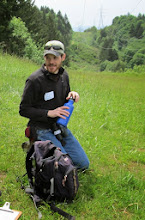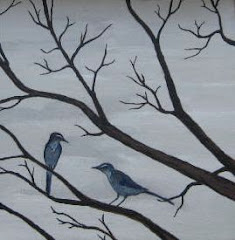
It is hard to imagine a more charismatic and appropriate bird for this honor. If there was to be a runner-up, however, I would nominate the black-chinned hummingbird.

During the spring and summer in central New Mexico, there is an unbelievable number of these little buzzers in this area. I doubt that an equal or greater number of individual hummingbirds can be found anywhere else in the country for such a long period of time. They buzz around towns, woodlands, and dry deserts and swarm around feeders. When you drive through farm country, you can spot them perched every wire and fence line. At the edge of the Rio Grande bosque, they dart out of the canopy to hover in search of flying insects. When the males are loaded with testosterone, they buzz up and down and side to side in spectacular territorial and aggressive displays.
Within the bosque, they are probably the most abundant nesting birds. Their nests are everywhere and nest survival rates are higher in this forest than in others studied in the region. The bosque is therefore a critical habitat for the southwestern population of this species. Forest Service crews find twice as many hummingbird nests as they do for the second most abundant nester, the mourning dove. During the last year I have been compiling results from eight years of study of over 700 nests. I will be presenting results from these analyses at the American Ornithologists Union meeting here in Portland later this summer. I needed some photos of nests and adults for my presentation, so one of my goals for the New Mexico trip was to view and photograph a few nests.
It did not take long.

When I arrived at my friends Geoff and Aaron's house, Aaron showed me a crazy nest built within the loop of a rope from which a plastic bottle was hung from the ceiling of a shed. This was the tallest nest I have ever seen of this species, it could have been a "double decker", a nest built on top of an old one. Like other nests of this bird, it was bright white because they are built with the cottony seeds of cottonwoods. Another example of the importance of these trees to life in the Rio Grande Valley.

The next day, while measuring vegetation at a wildfire site with the Forest Service crew, I heard a hummingbird buzz away from a very close distance, a sure sign of a nest.
After several minutes of searching we found the nest very low in a Russian olive shrub. The female was incubating two tiny eggs and was eager for us to move on to the next vegetation measurement point.
Results of my analyses suggest that Russian olive is their preferred nesting substrate when available and nests at low heights in shrubs are safer than those built high in trees such as cottonwoods.

I took a quick photo of the nest, but a pesky branch got in the way.
The day after we found the nest, I was checking out sites at Bosque Del Apache National Wildlife Refuge when, as luck would have it, some nice folks from Hummingbirds of New Mexico were capturing and banding Back-chins at the headquarters' feeders.

I was able to talk shop about hummingbird research and snap a few pictures that will look great in my presentation.
 As you can see, the male sports a shiny purple throat below his namesake black chin. The female is less distinctive, but can be identified by her long and slightly curved bill and overall skinny body shape, relative to other western hummingbird species.
As you can see, the male sports a shiny purple throat below his namesake black chin. The female is less distinctive, but can be identified by her long and slightly curved bill and overall skinny body shape, relative to other western hummingbird species.I found one more nest a few days later.

Unfortunately, the photo I took was out of focus, but it gives one an idea of how small and delicate the nests appear. Now that I have been re-immersed in their world, I can get back to work writing papers and presentations about one of my favorite New Mexico birds.






1 comment:
Hey Max,
I knew you were from MT but didn't realize you were a Butte boy. When did you work in Phillips Co.?
I am envious of your trip to NM. I haven't been for a long time despite good friends in Magdalena. One of these days. Looking forward to more NM stories.
Post a Comment